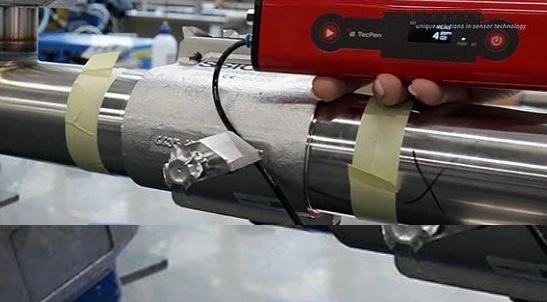 A portable trace oxygen analyzer verifies that 100% of the oxygen has been purged from the back side of TIG welded stainless steel, titanium, nickel or zirconium alloys. If oxygen gas is present at the weld point an inferior weld can occur. Trace oxygen analyzers are most often used to verify low oxygen levels when welding pipe or a hollow metal design.
A portable trace oxygen analyzer verifies that 100% of the oxygen has been purged from the back side of TIG welded stainless steel, titanium, nickel or zirconium alloys. If oxygen gas is present at the weld point an inferior weld can occur. Trace oxygen analyzers are most often used to verify low oxygen levels when welding pipe or a hollow metal design.
What is Weld Purging?
Weld purging is the displacement of oxygen from the backside of a weld. Stainless steel and some other metals are sensitive to the presence oxygen during TIG welding. The oxygen chemically combines with the hot metal as it is being joined and weakens the bond. Purging solves this problem by displacing the oxygen with an inert gas. It is most commonly used when welding pipe or other structural metal objects.
Why is Purging Necessary in Welding?
TIG welders are often asked to fix a pipe crack or leak from an improperly purged weld. The problem began when the original welder used a welding purge plug on one end of a pipe and aluminum tape on the other end to seal the interior for an argon gas purge. The original welder purged the pipe “for a while” until they guessed it was full of argon, and then started welding. Because argon is a colorless, odorless inert gas they have no way of verifying if all the oxygen is purged from the backside of the weld.
Once the weld is complete, the only verification that the purge successfully removed the oxygen from the backside of the weld is to visually examine it for carbide precipitation or “sugaring. If the backside of the weld cannot be seen, they may assume that because they used argon gas to purge the weld it is “good.”
In other cases, when welding a long stretch of stainless steel pipe the welder may start welding before the purge is complete. Depending on the length of the pipe, it may take hours to completely fill a pipe with argon gas. Even if the welder uses weld purge paper or inflatable stoppers to create a purge dam (not always allowed) they still cannot guarantee the oxygen purge was complete.
The issue of improperly back-purged welds becomes compounded when a TIG welding job is sub-contracted. Unless the contractor requires x-ray inspection of every weld, only a trace oxygen analyzer with data logging can verify the complete purging of oxygen before welding is started.
How Does a Trace Oxygen Analyzer Verify Purging?
A portable trace oxygen analyzer measures the oxygen level near the backside of a weld down to the parts-per-million (ppm) level. A hollow lance is inserted near the back side of a weld where a gas sample is taken. A micro-pump pulls the gas sample across a high-speed optochemical oxygen sensor and displays the oxygen level on the screen. Once the oxygen level measures 0% or less than 2 ppm the pipe can be considered “purged” and welding can be started.
An example of a trace oxygen analyzer for welding is the TecWeld TS-300 Weld Purge Monitor by TecSense. This oxygen sensor provides accurate measurements down to 0% oxygen for back purging of oxygen during welding. Learn more about the TecWeld Portable Weld Purge Monitor here.
Benefits of Using a Portable Trace Oxygen Analyzer
- Saves time: No need to rely on rough estimations of time to purge pipe.
- Saves money: reduces purge gas consumption to only the amount you need.
- Saves product: No welding too early. Produces a top-quality weld every time.